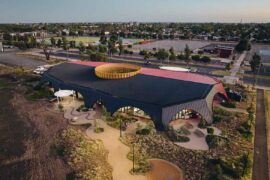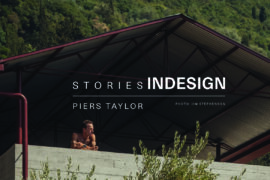Are we moving fast enough for the times? Dubai’s Municipality Circular #207 mandate for BIM reveals a shocking skills shortage within Australia’s AECO industries. And little interest in bridging the gap.

August 6th, 2018
So… USD$15,500,000,000,000.00. How’s that for preamble? I’m sure it has got your attention. It should – after all, as the value pipeline of the global construction industry forecasted for 2030, this mighty coffer of 15.5 trillion ‘big ones’ is allegedly what we’re all – engineer, architect, project manager, facility manager, supplier and property expert – hysterically trying to plunder.
Having said as much, it pains me to inform the vast majority of you that it’s unlikely you’ll receive a cut. The time has finally arrived for us to axe the culture of entitlement that is so endemic to Australia’s AECO industries. And in typical Australian fashion, we’re late to the party.
Despite unprecedented levels of local and foreign direct investment, our construction, architecture and engineering sectors remain sluggish, languishing in a mess of regulation and project management. Redundancies loom large. Inefficiencies prevail. And our approach to project financing is an embarrassing farce.
Two years ago, flourishing development potential in the Middle East prompted government bodies to shove a kibosh on the independent agency of architecture firms and consultancy practices. When Dubai’s primary public body – The Municipality – issued Circular #207 in 2015, it became the first federal authority in the Middle East to mandate the compulsory use of building information modelling (BIM) for big-ticket projects.
Hosannas were screamed across the Emirate. Finally, the world’s biggest meal-ticket megalopolis could mobilise investment capital, increase AECO employment capacity and accelerate development always before deadline, always under budget.
Pursuant to BIM, Circular #207 joins the ranks of comparable federal mandates throughout the United States, Europe and parts of Asia, all of which are profoundly transforming not only the process of construction and design, but also the business of construction and design contracting. In Dubai’s case, the rationale is direct and indisputable.
After the successful project management of the Midfield Terminal Complex development, Abu Dhabi Louvre Museum, Dubai Opera and all projects associated with the Road and Transports Authority, government officials and private investors alike applauded BIM’s potential to reduce construction costs, risks and stakeholder dissatisfaction.
By thwarting sizable inefficiencies, lax due diligence and imprudent asset identifications, Circular #207 stands as the Middle East’s first and sharpest clarion call to a new culture in the built environment: improved standards and protocols, more cost-and resource-effectiveness and, ultimately, a stronger foothold for the nation’s AECO industries overall.
As BIM adoption across the world continues to build momentum responding to these enforced mandates, the position of Australia’s architecture, engineering and construction communities comes under fire. In a recent report from the International Specialised Skills Institute, a mere 51 per cent of this professional community is engaged with BIM processes, implemented across only an approximate 30 per cent of its projects.
Such uninspiring numbers have led many to question the viability of our combined industries, drawing attention to unprecedented fragility in our national competitiveness.
As BIM adoption rates in this country remain in question, we watch on as UK and US companies enter our market with experienced and results-driven BIM methodologies. Given the volume of ‘leadership’ chest-beating coming from Australia’s architecture, construction, design and engineering sectors, we’re interested to know where these apparent hordes of ‘leaders’ have gone.
Hypocrisy and marketing aside, our characteristic lack of collaboration and efficiency in construction supply chain management threatens millions of dependent contractors, facilitators and, down to the national bottom line, the strength of our national GDP.
And yet, whether blue-chip or boutique, firms of all sizes and degrees of clout continue to run traditional operations (yes, a Revit file does not a BIM approach make) that, although superficially improved, at their core have remained impervious to the passing of 30 years.
With no transparency up and down the supply chain, much of the data and perspicacity of our combined practice is siloed, held in isolation and pertaining to a landslide of esoteric data sets.
We remain at a loss to access the evolving taxonomy of building elements. We remain at a loss to connect the IP of our Baby Boomer upper-executives to the Millennials who are becoming our workforce’s late majority. We remain at a loss for that $15.5 trillion. We remain at a loss.
INDESIGN is on instagram
Follow @indesignlive
A searchable and comprehensive guide for specifying leading products and their suppliers
Keep up to date with the latest and greatest from our industry BFF's!

For a closer look behind the creative process, watch this video interview with Sebastian Nash, where he explores the making of King Living’s textile range – from fibre choices to design intent.

At the Munarra Centre for Regional Excellence on Yorta Yorta Country in Victoria, ARM Architecture and Milliken use PrintWorks™ technology to translate First Nations narratives into a layered, community-led floorscape.

Sydney’s newest design concept store, HOW WE LIVE, explores the overlap between home and workplace – with a Surry Hills pop-up from Friday 28th November.

Merging two hotel identities in one landmark development, Hotel Indigo and Holiday Inn Little Collins capture the spirit of Melbourne through Buchan’s narrative-driven design – elevated by GROHE’s signature craftsmanship.

Crafting form and creating function with rattan, Patrick Keane and Enter Projects Asia’s latest project is proving to be a draw card for shoppers at the dynamic fashion house Massimo Dutti.

Piers Taylor joins Timothy Alouani-Roby at The Commons to discuss overlaps with Glenn Murcutt and Francis Kéré, his renowned ‘Studio in the Woods,’ and the sheer desire to make things with whatever might be at hand.

Hayley Mitchell and Samantha Eades are creating some of today’s best restaurants, most exciting cafés and bars, and extraordinary hotels and resorts.

The Australian Passivhaus Association (APA) has released a guide outlining the process for achieving the international Passivhaus Standard, providing clarity on appropriate use of the term and the legal risks of incorrect assertions.
The internet never sleeps! Here's the stuff you might have missed

The eponymous practice founder reflects on four decades of work in a new book launched by Lord Mayor Clover Moore, tracing lessons from New York to Sydney and revisiting seminal works including 8 Chifley Square and the Andrew “Boy” Charlton Pool.

Making a splash on the hair spa scene, the latest project from X + O makes a little slice of Japan right at home in suburban Melbourne.